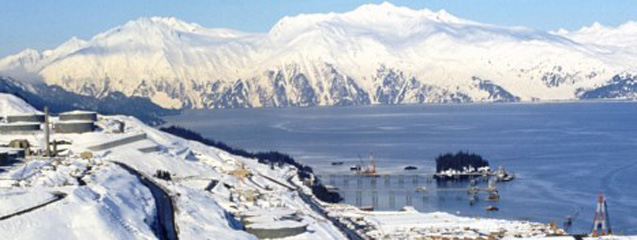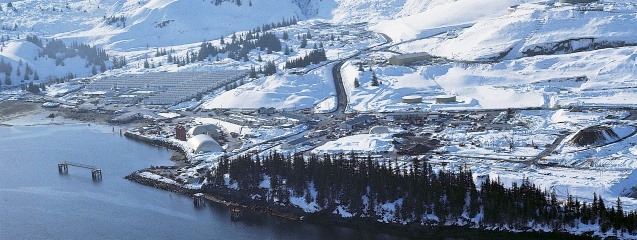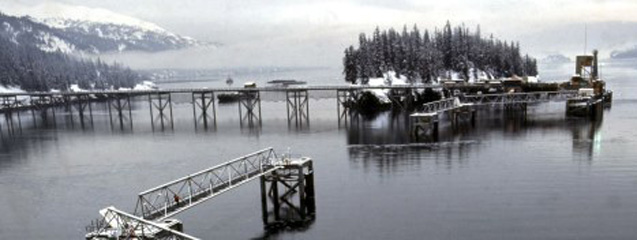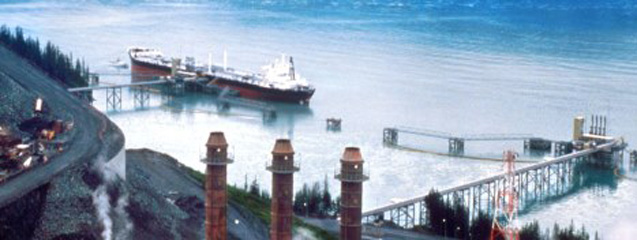Alyeska Trans-Alaska Oil Pipeline - EPC
Client:
North Slope, Alaska
Alyeska Pipeline Service Co.
Location:North Slope, Alaska

In 1977, Fluor completed engineering, procurement, and construction services for the Trans-Alaska pipeline, the largest pipeline in the world at the time. This challenging project required innovative design features for installing the 800-mile pipeline in arctic environments and over a variety of terrains. Additionally, a 1,000-acre marine terminal in an environmentally sensitive area was required at the Port of Valdez to receive the crude oil from the pipeline.
More than 7,000 craft workers and supervisors were needed to complete Fluor’s $2 billion project scope. Fluor designed and managed ten arctic construction camps—mini-cities—each with its own dormitories and food service, power generation, sewage disposal, heating, and water supply system.
More than 7,000 craft workers and supervisors were needed to complete Fluor’s $2 billion project scope. Fluor designed and managed ten arctic construction camps—mini-cities—each with its own dormitories and food service, power generation, sewage disposal, heating, and water supply system.
Client's Challenge

The Alyeska Pipeline Services Company, the company behind the pipeline, was a consortium of major oil companies that included BP Pipelines (Alaska) Inc., Phillips Transportation Alaska, Inc., ExxonMobil Pipeline Company, Unocal Pipeline Company, and Williams Alaska Pipeline Company, LLC. At the time of this project, the United States depended on the Trans-Alaska pipeline to deliver 17 percent of its domestic oil production. Revenues from oil production and transportation also provided about 80 percent of the Alaska government’s revenue. This project was the largest privately financed construction projects in history at the time: $4.5 billion trans-Alaskan pipeline system.
A major consideration of the overall project was protection of the pristine Alaskan environment. To assure minimal impact to the area, significant safeguards were designed and constructed for the pipeline and terminal.
A major consideration of the overall project was protection of the pristine Alaskan environment. To assure minimal impact to the area, significant safeguards were designed and constructed for the pipeline and terminal.
Solution

Fluor’s project scope for Alyeska consisted of 12 pump stations and three refrigeration plants on some of North America’s most rugged terrain; construction of one of the world’s largest marine terminals at Valdez, literally carved out of a mountainside; installation of control and power systems for 62 remotely operated gate valves; and meeting a schedule completion three years after construction startup, with subfreezing temperatures and blizzard-force winds.
Fluor’s project task force was comprised of technical experts that peaked at 800 personnel in its Southern California facility and expended more than 3 million work hours on their project scope. Tie-lines and data links connected the office in Alaska with the pumping stations, the Fairbanks construction office, the Valdez terminal, and the task force in California.
Fluor faced a major logistics challenge with the movement of personnel, materials, and equipment to the northern region of Alaska. Fluor set up a logistics terminal to handle trans-shipment of materials and equipment from the lower 48 states. Trucks and trains converged on Kenmore, Alaska for more than three years, offloading supplies to barges for shipment north. Nearly 400 thousand tons shipped from Kenmore and other points around the globe to job sites in Alaska.
Fluor’s project task force was comprised of technical experts that peaked at 800 personnel in its Southern California facility and expended more than 3 million work hours on their project scope. Tie-lines and data links connected the office in Alaska with the pumping stations, the Fairbanks construction office, the Valdez terminal, and the task force in California.
Fluor faced a major logistics challenge with the movement of personnel, materials, and equipment to the northern region of Alaska. Fluor set up a logistics terminal to handle trans-shipment of materials and equipment from the lower 48 states. Trucks and trains converged on Kenmore, Alaska for more than three years, offloading supplies to barges for shipment north. Nearly 400 thousand tons shipped from Kenmore and other points around the globe to job sites in Alaska.
Conclusion

Fluor completed the 800-mile pipeline project for Alyeska despite sub-zero temperatures, rough terrain, and the logistics of moving personnel, material, and equipment to project sites in remote Northern Alaska.
Additionally, Fluor designed and built the 1,000-acre marine terminal with major consideration of the environment and terrain. The company had to consider various conditions when designing the terminal, including onshore topography, offshore water depths, foundation soil, and local environmental design criteria.
As with all Fluor projects, the company took extensive measures to ensure the safety of all personnel working on the project.
On August 1, 1977, after traveling the breadth of Alaska, 824,000 barrels of North Slope crude left Alaska, the first of an estimated 10 billion barrels to journey through the Trans-Alaska Pipeline System.
Read about other Fluor Constructors projects.
Additionally, Fluor designed and built the 1,000-acre marine terminal with major consideration of the environment and terrain. The company had to consider various conditions when designing the terminal, including onshore topography, offshore water depths, foundation soil, and local environmental design criteria.
As with all Fluor projects, the company took extensive measures to ensure the safety of all personnel working on the project.
On August 1, 1977, after traveling the breadth of Alaska, 824,000 barrels of North Slope crude left Alaska, the first of an estimated 10 billion barrels to journey through the Trans-Alaska Pipeline System.
Read about other Fluor Constructors projects.

